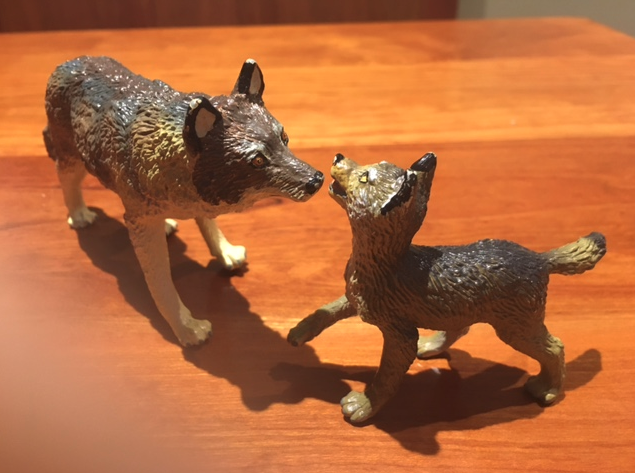Wolves in the Land of Salmon
by David Moskowitz
and other Wolf Stories
By Anne Kilgannon
Many of us are now familiar with the Yellowstone National Park story, where wolves are brought back to the park in 1995 to “do what wolves do.” As the restored wolves harried and hunted elk, deer, bison, and whatever else filled their needs, their presence and actions transformed the complex ecosystem of the park fauna and—surprising to some—the flora, too, and even the complicated hydrology of that landscape. The story can read like a classic morality tale: first, this happens, and then this, and then the impacts ripple through until everything is touched and different, but owing to the basics of biology instead of magic. Complacent ungulates confronted with active predators stopped grazing stream banks and other easy pickings and became wary and less cow-like in their eating habits. Their out-of-control multiplying population now came under predator control, which, paradoxically, strengthened the herd by removing its weakest members. Streamside vegetation recovered, beavers returned with the renewed growth of willows and built their dams, which slowed and cleansed water courses, and with returning stream health, fish, amphibians and turtles, and smaller mammals that relied on aquatic sources flourished once again. And notably, songbirds multiplied in the restored landscape. Tracing such far-reaching impacts of the wolf reintroduction ignited the imaginations of many biologists and tourists alike.
Wildlife tracker, photographer, and biologist David Moskowitz are deeply familiar with the links in this complex web of predator-prey relations and how extensively their dynamics spread throughout the food webs. He has spent years of study, wild-land exploration, and close observation throughout the Pacific Northwest documenting the return of wolves to our region. Wolves in the Land of Salmon brings that work together for us. He begins with the basics, explaining the physiology of wolves, from the shape of their legs and feet to their digestive systems, their reproductive patterns, and social organization. His prose is matched by his stunning photographs of the landscape world of these beautiful animals; their close-up portraits gleam with intelligence and strength. We are captivated at once and willing to bushwhack with Moskowitz up and down every mountain and through the forests and wetlands as he tracks the various packs establishing themselves anew. Along the way, we will vicariously experience the backcountry in a way few of us could manage on our own.
Wolves have played an intricate role in the West since the glaciers melted and life returned to the land. They helped create a healthy balance as keystone predators, coexisting and competing with mountain lions and bears, and keeping the ungulates in a healthy condition. Ravens and smaller carnivores also benefited from the wolves’ success in hunting as did the trees and shrubs and all that depended upon a controlled population of browsing animals. The humans who established their families in the emerging territories adopted the wolf as kin, recognizing them as equals and role models. There might be times of hunger but the web held and life filled all the niches in the land and seashores. Just one of the “fun facts” to share: Did you know wolves ate salmon? They are true denizens of our homeland.
Then, with the influx of American settlers, the practice of cattle and sheep raising spread over both private and public lands, subsidized by government programs. This new enterprise significantly impacted the biotic community as the introduced domestic animals over-grazed fields and forests, trampled streambeds, and outcompeted native foragers. To make the country “safe” for stock-raisers, market hunters and zealously anti-wolf game officials extirpated wolves from our area by the early decades of the last century. The “new normal” was vigorously maintained until recent years when the tide began to turn against this truncated ecosystem.
Wolves eventually began to trickle back into the area from some of the wilder stretches of Canada, welcomed and aided by some and greeted with alarm among ranchers and others who were unprepared for such icons of wildness in their midst. It’s been a see-saw struggle ever since, with government agents quick to exterminate members of the new packs at the behest of some, while others protested and gathered evidence that wolves are a needed part of our world. Moskowitz has been a valuable member of the group studying wolves and their role in maintaining healthy ecosystems. His work as displayed here in this timely and wondrous book will help us sort out truth from myth, science from prejudice and fear. The more we know about the lives of wolves the wiser we can act to weave them back into their rightful place in the scheme of life in the Pacific Northwest. Standing up for wolves will restore a crucial missing piece; it’s even good for birds!
It’s become a tradition here as holiday time approaches to recommend nature books as gift ideas. Certainly, Wolves in the Land of Salmon would make a very handsome and thoughtful present for adults, but if the younger set is on your list, you can find books about wolves suitable for them, too. Let’s break away from stories that paint wolves as scary and rapacious and look for books that portray their majesty and mystery. I found many good examples to preview at the library, but my favorites were The Eyes of Gray Wolf, by Jonathan London and illustrated by Jon Van Zyle, and one telling the Yellowstone renewal story, The Wolves Are Back, by Jean Craighead George, illustrated by Wendell Minor. George is also the author of the classic for older readers, Julie of the Wolves. Another classic for even older readers—that would be the rest of us—is Farley Mowat’s hilarious and yet still serious Never Cry Wolf. Rounding up the pack, Barry Lopez writes eloquently about wolves in several of his works; try Of Wolves and Men. One for yourself and one for your list! Happy reading and Happy Holidays!
Photo credit: Wolf and Pup, by Anne Kilgannon.








